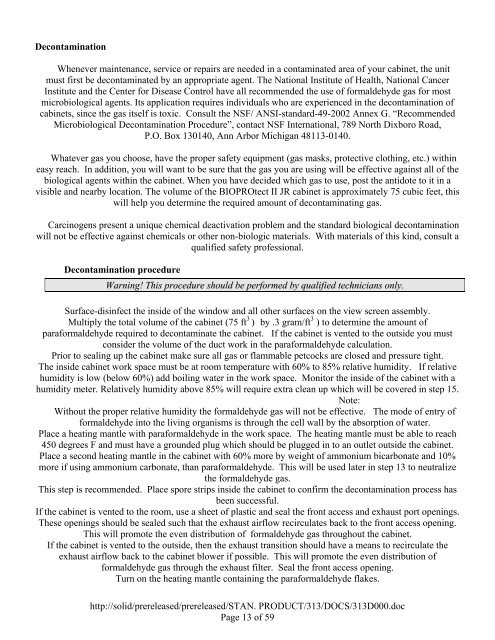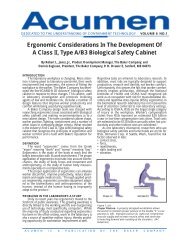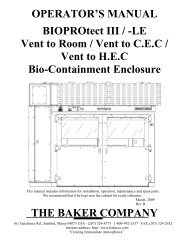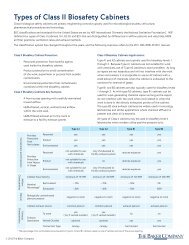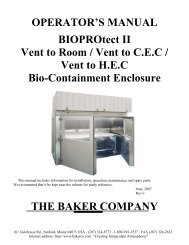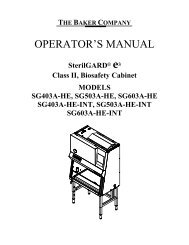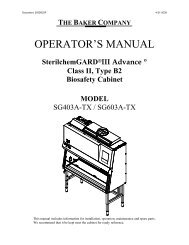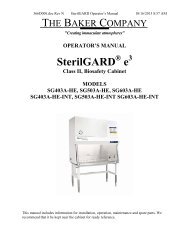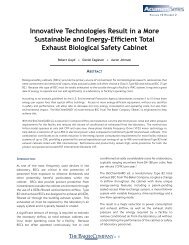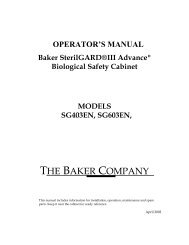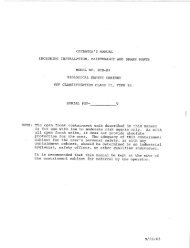OPERATOR'S MANUAL BIOPROtect II JR Vent to ... - Baker Company
OPERATOR'S MANUAL BIOPROtect II JR Vent to ... - Baker Company
OPERATOR'S MANUAL BIOPROtect II JR Vent to ... - Baker Company
Create successful ePaper yourself
Turn your PDF publications into a flip-book with our unique Google optimized e-Paper software.
Decontamination<br />
Whenever maintenance, service or repairs are needed in a contaminated area of your cabinet, the unit<br />
must first be decontaminated by an appropriate agent. The National Institute of Health, National Cancer<br />
Institute and the Center for Disease Control have all recommended the use of formaldehyde gas for most<br />
microbiological agents. Its application requires individuals who are experienced in the decontamination of<br />
cabinets, since the gas itself is <strong>to</strong>xic. Consult the NSF/ ANSI-standard-49-2002 Annex G. “Recommended<br />
Microbiological Decontamination Procedure”, contact NSF International, 789 North Dixboro Road,<br />
P.O. Box 130140, Ann Arbor Michigan 48113-0140.<br />
Whatever gas you choose, have the proper safety equipment (gas masks, protective clothing, etc.) within<br />
easy reach. In addition, you will want <strong>to</strong> be sure that the gas you are using will be effective against all of the<br />
biological agents within the cabinet. When you have decided which gas <strong>to</strong> use, post the antidote <strong>to</strong> it in a<br />
visible and nearby location. The volume of the <strong>BIOPROtect</strong> <strong>II</strong> <strong>JR</strong> cabinet is approximately 75 cubic feet, this<br />
will help you determine the required amount of decontaminating gas.<br />
Carcinogens present a unique chemical deactivation problem and the standard biological decontamination<br />
will not be effective against chemicals or other non-biologic materials. With materials of this kind, consult a<br />
qualified safety professional.<br />
Decontamination procedure<br />
Warning! This procedure should be performed by qualified technicians only.<br />
Surface-disinfect the inside of the window and all other surfaces on the view screen assembly.<br />
Multiply the <strong>to</strong>tal volume of the cabinet (75 ft 3 ) by .3 gram/ft 3 ) <strong>to</strong> determine the amount of<br />
paraformaldehyde required <strong>to</strong> decontaminate the cabinet. If the cabinet is vented <strong>to</strong> the outside you must<br />
consider the volume of the duct work in the paraformaldehyde calculation.<br />
Prior <strong>to</strong> sealing up the cabinet make sure all gas or flammable petcocks are closed and pressure tight.<br />
The inside cabinet work space must be at room temperature with 60% <strong>to</strong> 85% relative humidity. If relative<br />
humidity is low (below 60%) add boiling water in the work space. Moni<strong>to</strong>r the inside of the cabinet with a<br />
humidity meter. Relatively humidity above 85% will require extra clean up which will be covered in step 15.<br />
Note:<br />
Without the proper relative humidity the formaldehyde gas will not be effective. The mode of entry of<br />
formaldehyde in<strong>to</strong> the living organisms is through the cell wall by the absorption of water.<br />
Place a heating mantle with paraformaldehyde in the work space. The heating mantle must be able <strong>to</strong> reach<br />
450 degrees F and must have a grounded plug which should be plugged in <strong>to</strong> an outlet outside the cabinet.<br />
Place a second heating mantle in the cabinet with 60% more by weight of ammonium bicarbonate and 10%<br />
more if using ammonium carbonate, than paraformaldehyde. This will be used later in step 13 <strong>to</strong> neutralize<br />
the formaldehyde gas.<br />
This step is recommended. Place spore strips inside the cabinet <strong>to</strong> confirm the decontamination process has<br />
been successful.<br />
If the cabinet is vented <strong>to</strong> the room, use a sheet of plastic and seal the front access and exhaust port openings.<br />
These openings should be sealed such that the exhaust airflow recirculates back <strong>to</strong> the front access opening.<br />
This will promote the even distribution of formaldehyde gas throughout the cabinet.<br />
If the cabinet is vented <strong>to</strong> the outside, then the exhaust transition should have a means <strong>to</strong> recirculate the<br />
exhaust airflow back <strong>to</strong> the cabinet blower if possible. This will promote the even distribution of<br />
formaldehyde gas through the exhaust filter. Seal the front access opening.<br />
Turn on the heating mantle containing the paraformaldehyde flakes.<br />
http://solid/prereleased/prereleased/STAN. PRODUCT/313/DOCS/313D000.doc<br />
Page 13 of 59


